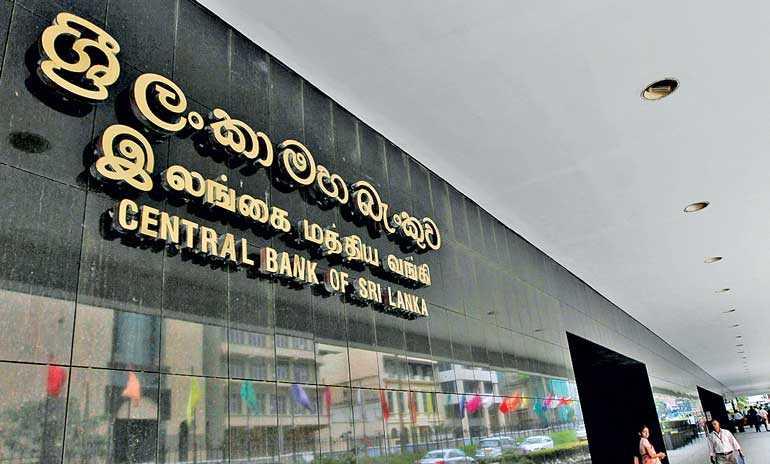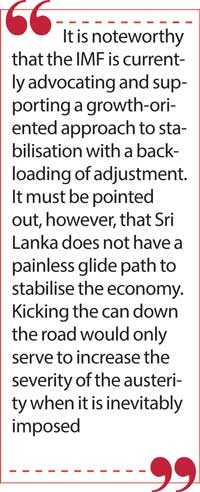Monday Mar 17, 2025
Monday Mar 17, 2025
Tuesday, 9 February 2021 00:51 - - {{hitsCtrl.values.hits}}

For IMF support to be secured, there has to be a clear medium term plan to achieve debt sustainability
The Sri Lankan authorities have been able to achieve stable macro-economic indicators despite the severe economic dislocation caused by the pandemic. Inflation has remained well within the 4-6% target range; and the improvement of the trade deficit has had a positive impact on the current account of the Balance of Payments.
In addition, interest rates are at historically low levels and there has been some stability in the exchange rate. As in most other countries, growth has been negative, due to both demand and supply shocks in the domestic economy and the decline of external demand due to the slowdown of the global economy. 
Sri Lanka’s performance has been better than a number of other countries in the region. However, the model that has underpinned the significant degree of stability in macro-economic indicators to date, is now coming under considerable pressure. The extremely low interest rates have been maintained through administrative action (financial repression). The under-subscription in bill and bond auctions are signs that this policy is coming under stress in a context where credit to government remains high while private sector credit is picking up.
At the same time, the currency has also come under pressure. The LKR has been propped up by restrictions on imports and capital outflows. Recently, a ban has also been imposed on forward transactions in the forex market.
Despite (or because of) this, there continues to be stress in the forex market as imports rise with the bounce-back of the economy from its contraction in 2020. In addition, the prices of oil and other key commodity imports have been rising in global markets increasing the demand for dollars in the local forex market at a time when supply remains constrained, due to a shortage of foreign earnings/inflows, borrowed or non-borrowed.
The import and capital restrictions currently in place have a negative impact on growth, employment and incomes at a time when priority needs to be attached to bouncing back from the economic scarring inflicted by the pandemic.
The most imminent threat to macro-economic stability, which can affect the whole economy, comes from the Balance of Payments, the external payments in particular. Sri Lanka’s external debt dynamics are extremely challenging over the next six months and urgent action is needed to address them and mitigate collateral damage which can have wide-ranging social and political ramifications.
Gross foreign external reserves amounted to $ 5.7 billion (including $ 400 million in gold) as at 31 December 2020. Total debt-related payments during the next six months (February-July 2021) comprise: an ISB maturity of $ 1 billion; SLDB maturities of $ 980 million; and interest payments of $ 482 million. In addition, the Reserve Bank of India (RBI) SARC SWAP of $ 400 million would need to be repaid this month (February 2021). This is intended to be a short term facility and cannot be extended further without staff-level agreement on an IMF Arrangement.
In normal circumstances, the expectation is that SLBDs would be rolled over. However, only 25% of the maturities of USD 200 million was rolled over at the last auction. This reflects the severe scarcity of Forex in the market.
There is uncertainty, therefore, regarding how much of the maturing SLDBs of $ 980 m can be rolled over during the next six months. Any shortfall will deplete the external reserves. The shortage of foreign exchange is also likely to adversely affect the rollover of short term SWAPs with FCBUs which will be maturing over the next six months.
The upshot of all this is that there is a strong possibility that reserves will fall to extremely dangerous levels within the next six months (by July 2021). Unless there are significant inflows in the meantime, there will have to be severe compression of domestic absorption (consumption and investment), i.e., very painful austerity. Instead of a recovery, the economy could well experience further contraction. It becomes important, therefore, to examine the likelihood of inflows which would serve to offset the heavy debt-servicing burden over the next six months.
Sri Lanka’s development partners (multi-lateral and bilateral) are expected to disburse $ 1.7 billion during the course of the whole of 2021. Some of this would be flowing in over the next six months. However, because this is project and program lending, it would not be possible to utilise this funding to boost the external reserve position. Furthermore, the rating downgrades have meant that Sri Lanka is no longer able to access international capital markets at affordable rates (currently 15%) thereby curtailing a potential source of financing.
Specific sources, which have been announced by the authorities to fill the external financing gap, include the following:
- Term loan from the China Development Bank: $ 700 million
- SWAP facility from the People’s Bank of China: Yuan 10 billion; equivalent to $ 1.5 billion (this facility could have conditions that will constrain its capacity to bolster usable reserves)
- SWAP facility from the RBI: $ 1 billion (this facility is tied to Port development and removal of some import restrictions complicating the completion of negotiations).
The delay in the completion of these transactions seems to indicate that there are challenges in each of these negotiations. Even if all three of these facilities materialise, it is extremely unlikely that it would be possible to get sustained bilateral support of this nature in the magnitudes required to meet the country’s debt obligations of $ 23 billion over 2021-2025. Hence one needs another approach that unlocks a wider base for sourcing external financing.
The second option is to seek the support of the IMF. This will also serve to leverage a number of other sources of external financing. Over 70 countries have been assisted by the IMF through the Emergency Facilities established by the Fund to provide countries with fast-disbursing financing to address the impact of the pandemic.
Sri Lanka would be eligible for up to $ 830 million, based on need, from the Rapid Financing Instrument. An arrangement with the IMF can also trigger direct budgetary support from the ADB ($ 500 million) and the World Bank (about $ 300 million). It can also pave the way for a rating upgrade and eventually regaining access to international capital markets.
Anchoring policies to an IMF arrangement would also provide foreign investors with greater confidence to invest in the country. However, in the present global and domestic climate, it is unrealistic to expect that FDI will play a major role in filling the external financing gap, particularly in the short term.
It is also noteworthy that it is difficult to utilise FDI to give a direct boost to gross official external reserves as much of it would flow out of the country in the form of imports and other payments incurred by the foreign investor. However, in the medium term, FDI can increase the capacity to service debt by contributing to an increase in the production of tradables which would earn or save foreign exchange.
For IMF support to be secured, there has to be a clear medium term plan to achieve debt sustainability. The Fund’s Articles do not permit it to lend to countries where it cannot certify that the debt is sustainable. At present, the IMF could find it difficult to certify that this is so. All options would need to be considered including fiscal adjustment, as well as a market-friendly reprofiling of Sri Lanka’s external debt through an extension of maturities and some relief on coupon payments. This would serve to create some space both in the Government Budget and the Balance of Payments for growth-oriented stabilisation.
It is noteworthy that the IMF is currently advocating and supporting a growth-oriented approach to stabilisation with a backloading of adjustment. It must be pointed out, however, that Sri Lanka does not have a painless glide path to stabilise the economy. Kicking the can down the road would only serve to increase the severity of the austerity when it is inevitably imposed.
It is crucial that there is early and decisive action as a very disruptive hard default, involving haircuts for creditors, could well be looming on the horizon. There are signs that Sri Lanka is facing solvency rather than liquidity challenges. As experienced in other countries, such a default usually means soaring interest rates, a collapse of the currency and severe belt-tightening, which tends to impact the poor and vulnerable disproportionately with unpredictable social and political ramifications.
The longer-term solution for achieving sustainable debt dynamics involves running a primary surplus in the budget and promoting an accelerated growth trajectory.
This involves not only stabilisation of macro fundamentals but also structural reforms to increase productivity/competitiveness of the economy. Increasing investment, including FDI, and boosting the production of tradables, particularly exports, need to be an integral part of this narrative. The Pathfinder Foundation set out a roadmap to achieve this in its Report, ‘Pathfinder Beyond the Box: A New Economic Vision for Post-COVID-19 Sri Lanka’ in May 2020.
(This is a Pathfinder Economic Alert of the Pathfinder Foundation. Readers’ comments are welcome at www.pathfinderfoundation.org.)
Discover Kapruka, the leading online shopping platform in Sri Lanka, where you can conveniently send Gifts and Flowers to your loved ones for any event including Valentine ’s Day. Explore a wide range of popular Shopping Categories on Kapruka, including Toys, Groceries, Electronics, Birthday Cakes, Fruits, Chocolates, Flower Bouquets, Clothing, Watches, Lingerie, Gift Sets and Jewellery. Also if you’re interested in selling with Kapruka, Partner Central by Kapruka is the best solution to start with. Moreover, through Kapruka Global Shop, you can also enjoy the convenience of purchasing products from renowned platforms like Amazon and eBay and have them delivered to Sri Lanka.
Discover Kapruka, the leading online shopping platform in Sri Lanka, where you can conveniently send Gifts and Flowers to your loved ones for any event including Valentine ’s Day. Explore a wide range of popular Shopping Categories on Kapruka, including Toys, Groceries, Electronics, Birthday Cakes, Fruits, Chocolates, Flower Bouquets, Clothing, Watches, Lingerie, Gift Sets and Jewellery. Also if you’re interested in selling with Kapruka, Partner Central by Kapruka is the best solution to start with. Moreover, through Kapruka Global Shop, you can also enjoy the convenience of purchasing products from renowned platforms like Amazon and eBay and have them delivered to Sri Lanka.